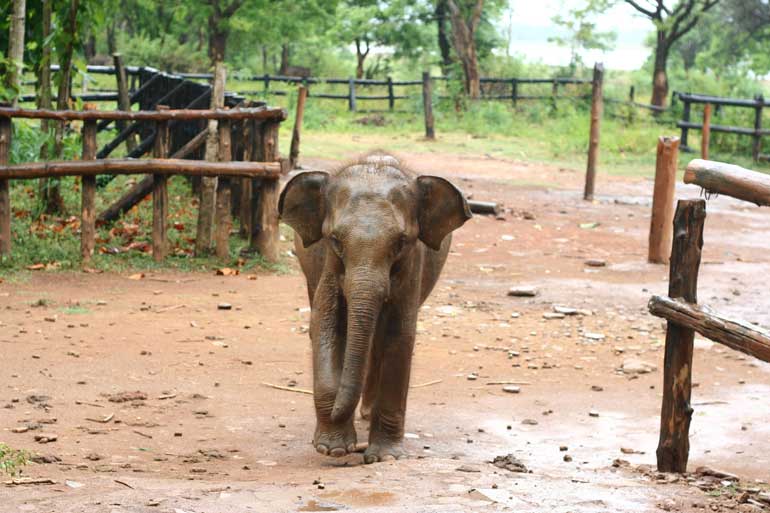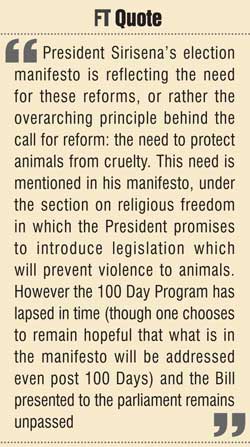Saturday Jan 18, 2025
Saturday Jan 18, 2025
Saturday, 23 May 2015 00:00 - - {{hitsCtrl.values.hits}}
 With changes to governance being set up, and the enthusiasm which comes with it, would this not be the appropriate time that we give serious thought to the proposed legal reforms on cruelty to animals, and establish compassion which extends beyond just the humans in the land?
With changes to governance being set up, and the enthusiasm which comes with it, would this not be the appropriate time that we give serious thought to the proposed legal reforms on cruelty to animals, and establish compassion which extends beyond just the humans in the land?
By Vositha Wijenayake
Recently a video which was shared by a Sri Lankan on his Facebook managed to grab a lot of attention. Why? Many reasons. One probably being that some people liked watching cruelty to animals, the other due to a petition which was launched against the video, requesting that the man be punished for cruelty he inflicted on the animal. More specifically a cat, which was been taunted for a human’s entertainment. 
A few questions remained unanswered. One includes the identity of the individual on the video, who speaks in Tamil to the cat, throwing it around, in the air, flipping him from side to side, and also carrying the animal by his neck, with his mouth as a cat would carry his kittens. This obviously creates a question as to the mental stability of the human who seems to be behaving not humane. Despite the petition’s call for punishing of the individual who has shared the video given the dilemma mentioned one cannot be assured whether it is the sharer who is in the video or not.
In addition to the lack of clarity of the individual, the biggest hurdle to take action against this sort of individuals remains the law. The law that is archaic, outdated with fines which are too low and with implementation that is almost never. If one has not heard of filed a case against anyone being fined for hitting his cat, not feeding it, or injuring it by throwing fire crackers at it, this would be due to the non-implementation of the law on animal cruelty in Sri Lanka, as well as the short-comings pertaining to it.
Cruelty to animals
Cruelty to animals is defined by Prevention of Cruelty to Animals Ordinance No. 13 of 1907 as amended by No.19 of 1912, 43 of 1917, 9 of 1919, 23 of 1921, 16 of 1927, 17 of 1930, 12 of 1945 and Act no. 22 of 1955.
According to section 2 of the Ordinance, the offence of cruelty is defined as including cruelly beat, ill-treat, over-drive, or cause or procure to be cruelly beaten, ill-treated, over-driven, over-ridden, abused or torture any animal; cause unnecessary pain or suffering to any animal by an act or omission, as well as convey or carry or cause them in vehicles, basket, box, or cage or otherwise, any animal or position animals so as to subject them to unnecessary pain or suffering. The penalty for this offence is provided as a fine that may extend to hundred rupees, or imprisonment (maximum three months) or both.
Further section 3 provides, “If any animal is found to be suffering and in pain by starvation the owner is guilty of an offence.” The punishment for THIS offence is at fine of hundred rupees, or imprisonment that may extend to three months or both.
One of the issues of the Legislation are the penalties which are trivial and not detrimental in its effect which fail to prevent cruelty to animals. The law that was passed over 100 years ago unfortunately fails from being taken seriously due to this.
Defining “animal”
Another shortcoming of the current law on animal cruelty is the interpretation on what constitutes an “animal” under this Ordinance. In section 14, the interpretation provided states, “Animal means any domestic or captured animal and includes any bird, fish, or reptile in captivity.” This in turn limits the compassion that needs to be shown to animals to only those animals considered in human custody, which in turn provides space to be cruel to those that are not.
Sri Lankan case law provides that an animal that is a “wild” animal would not come within the protection of this Ordinance. In the case of Inspector, Society for the Prevention of Cruelty to Animals, Nawalapitiya v. Punchirala et al (1922) 24 NLR 202 a number of people were charged for chasing a wild elk, which had not been previously captured, and killing it in a cruel manner. It was held that the accused were not punishable under the Prevention of Cruelty to Animals Ordinance, No.13 of 1907 as the wild elk was not ‘an animal’ within the meaning of the term in the Ordinance and in turn were acquitted.
Need for reform
To address the shortcomings of the law on animal cruelty, proposal for reform was presented in the form of a Bill to the Parliament by Ven. Athuraliye Rathana Thero, on 19 October 2010. The new legislation which is proposed has as its objective to replace the Prevention of Cruelty to Animals Ordinance of 1907, and to recognise duty of care for persons in charge of animals to treat the animals humanely, to prevent cruelty to animals and to secure the protection and welfare of animals, to establish a National Animal Welfare Authority and Regulations and Codes of Practice and to raise awareness on animal welfare.
The Bill provides that a person in charge of an animal owes a duty of care to it, and that it shall be the duty of every person in charge of an animal to take all reasonable measures to ensure the well-being of such animal; and to prevent the infliction upon such animal of unnecessary fear or pain; and to provide such animal with food, water, hygienic living conditions, adequate living space and shelter that is appropriate; and reasonably practicable for the person to provide.
Proposed law on cruelty to animals
The proposed law addresses cruelty to animals, and elaborates it to include beating, kicking, overriding, overdriving, overloading, overworking, torturing, terrifying, or otherwise treats an animal so as to subject it to unnecessary pain. It also proposes for it to an offence where a person in charge of an animal permits the animal to be so treated. This also includes using an animal in any work or labour or for any other purpose for which by reason of any disease, infirmity, wound, or other cause, such animal is unfit to be so used or training an animal in a way that is detrimental to its health and welfare, including forcing an animal to exceed its natural capacities or strength.
The Bill also proposes cruelty to animals to include wilfully and unreasonably administering any poison, injurious drug or substance to an animal or wilfully and unreasonably causing or attempting to cause any poison, injurious drug or substance to be taken by an animal. It also covers transport of animals by bringing within the interpretation conveying or carrying an animal in such a manner or position as to subject it to pain. Additionally keeping or confining an animal in any cage or any place that does not measure sufficiently in height, length and breadth to permit the animal a reasonable opportunity for movement will also be construed as cruelty to animals under the proposed law.
The suggested penalty upon conviction for the above mentioned offence is set to be a fine not exceeding fifty thousand rupees or to imprisonment for a term not exceeding two years or to both such fine and imprisonment.
A compassionate Government?
President Sirisena’s election manifesto is reflecting the need for these reforms, or rather the overarching principle behind the call for reform: the need to protect animals from cruelty. This need is mentioned in his manifesto, under the section on religious freedom in which the President promises to introduce legislation which will prevent violence to animals. However the 100 Day Program has lapsed in time (though one chooses to remain hopeful that what is in the manifesto will be addressed even post 100 Days) and the Bill presented to the parliament remains unpassed.
With changes to governance being set up, and the enthusiasm which comes with it, would this not be the appropriate time that we give serious thought to the proposed legal reforms on cruelty to animals, and establish compassion which extends beyond just the humans in the land?